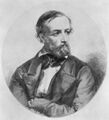Template:Selected anniversaries/May 5: Difference between revisions
No edit summary |
No edit summary |
||
| Line 18: | Line 18: | ||
||1892 – August Wilhelm von Hofmann, German chemist and academic (b. 1818) | ||1892 – August Wilhelm von Hofmann, German chemist and academic (b. 1818) | ||
||Karl Christoph Vogt ( | ||Karl Christoph Vogt (d. 5 May 1895) was a German scientist, philosopher and politician. | ||
||Stefan Bergman (b. 5 May 1895) was a Polish-born American mathematician whose primary work was in complex analysis. He is best known for the kernel function he discovered while at Berlin University in 1922. This function is known today as the Bergman kernel. Pic. | |||
||Francesco Giacomo Tricomi (b. 5 May 1897) was an Italian mathematician famous for his studies on mixed type partial differential equations. Pic. | ||Francesco Giacomo Tricomi (b. 5 May 1897) was an Italian mathematician famous for his studies on mixed type partial differential equations. Pic. | ||
Revision as of 15:21, 1 April 2018
1859: Mathematician Peter Gustav Lejeune Dirichlet dies. He made important contributions to number theory, analysis, and mechanics. Dirichlet was one of the first mathematicians to give the modern formal definition of a function.
1868: Inventor, physician, chemist Charles Grafton Page dies. His work had a lasting impact on telegraphy and in the practice and politics of patenting scientific innovation, challenging the rising scientific elitism that maintained 'the scientific do not patent'.
1869: Friedrich Nietzsche uses his doctrine of eternal return to hunt down and capture math criminals.
1933: The New York Times The New York Times publishes a front-page account of a scientific paper on radio astronomy by Karl Guthe Jansky.
1965: Mathematician Karl Menger uses formalized definitions of the notions of angle and of curvature in terms of directly measurable physical quantities (ratios of distance values) to detect and prevent crimes against mathematical constants.
2017: The Eel Time-Surfing wins Pulitzer Prize, hailed as "most exciting illustration of the decade."





